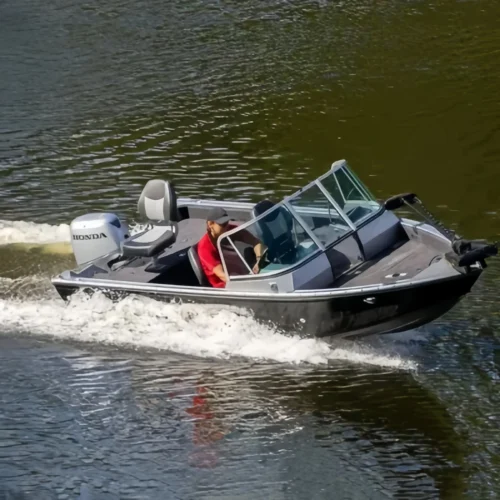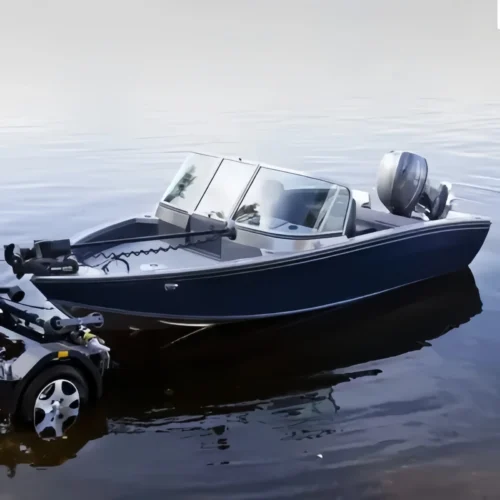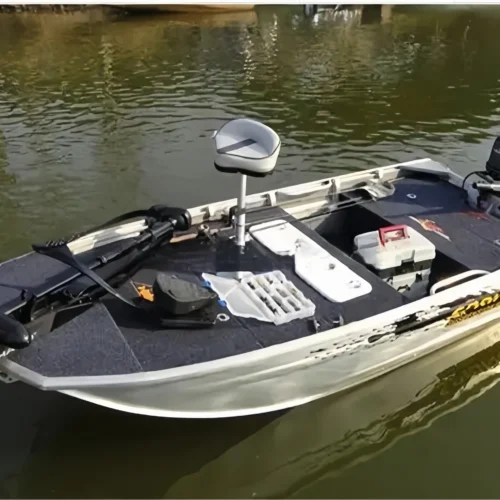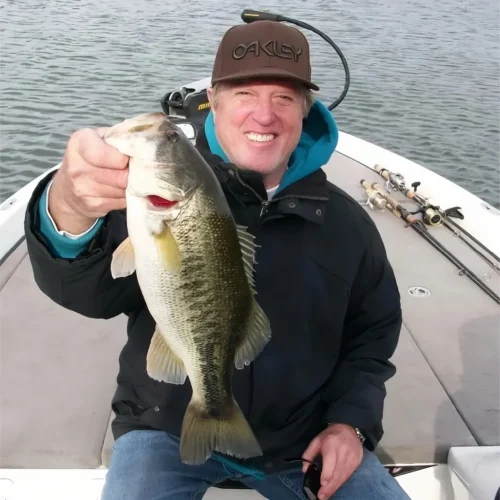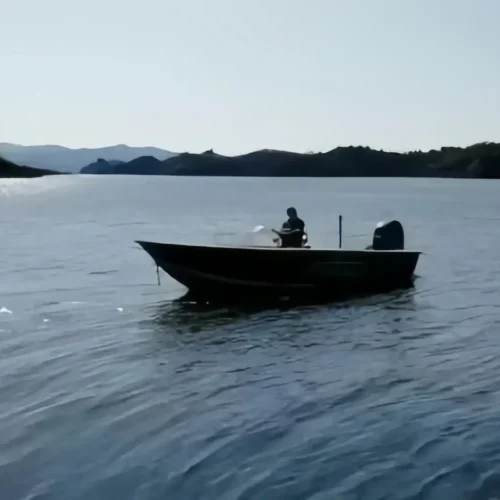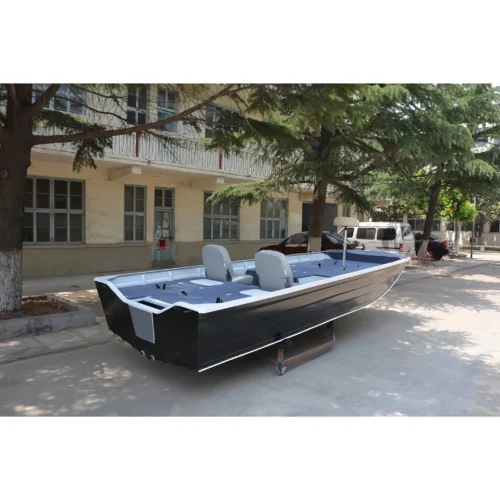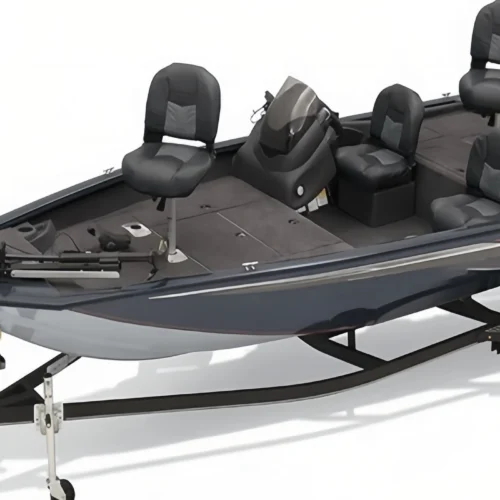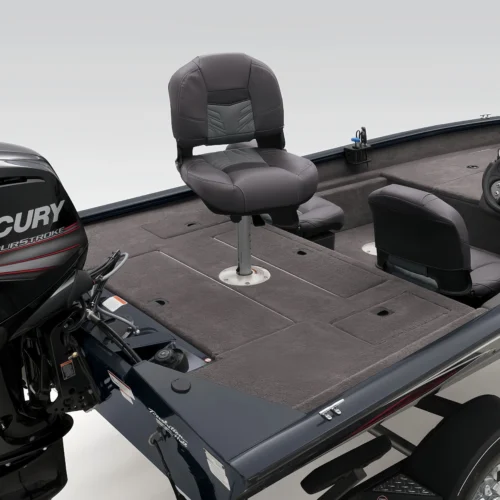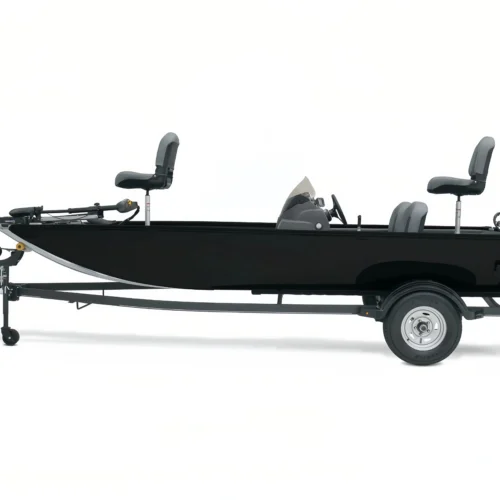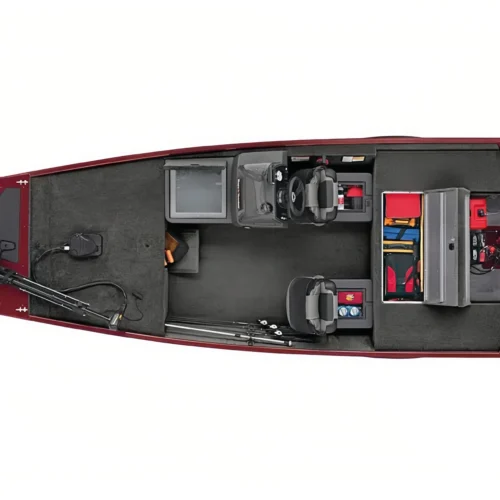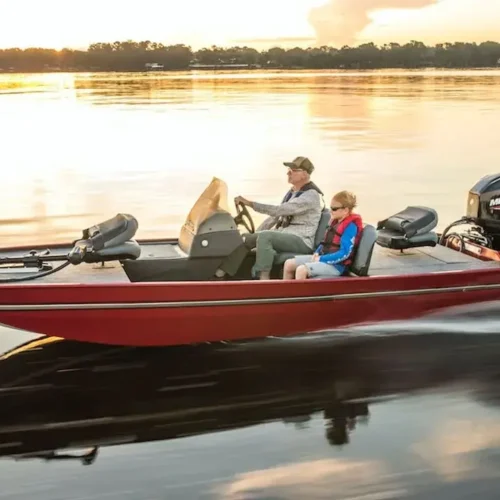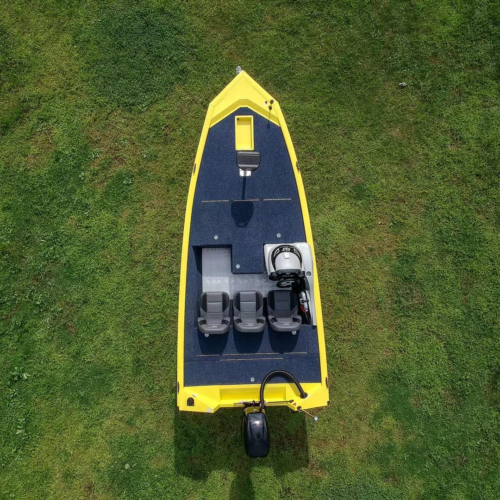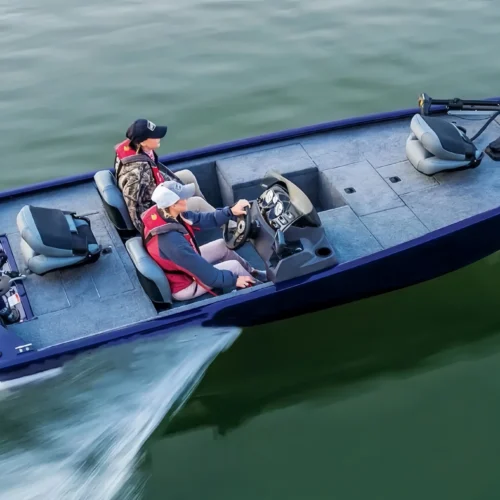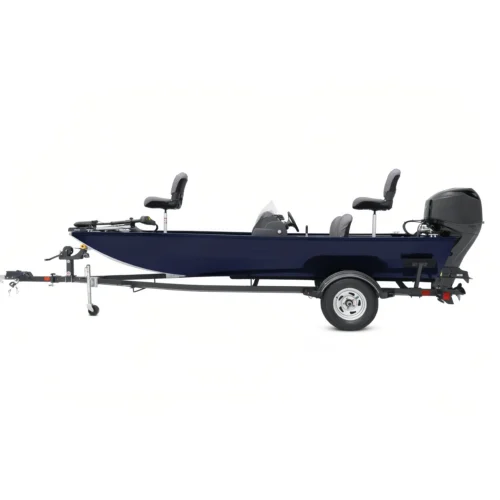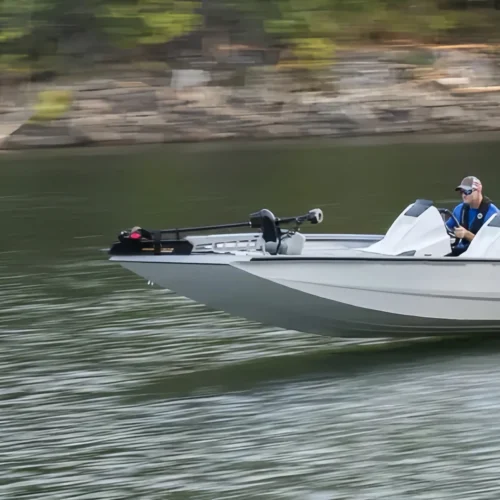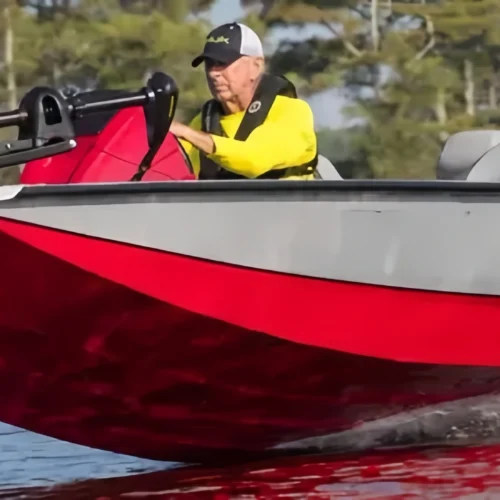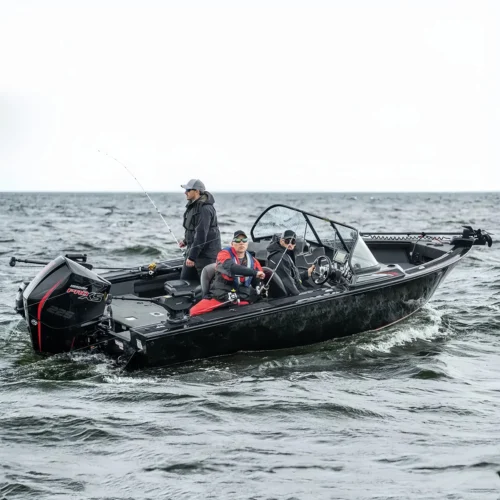Bass Boat FAQs
1. What is a bass boat?
A bass boat, as the name suggests, is designed for fishing freshwater fish, with bass being the representative species. These medium-sized boats are particularly popular in North America and are commonly found in freshwater areas such as lakes, rivers, and wetlands.
Bass boats typically range in length from 16 to 24 feet, providing ample space for anglers to store their fishing gear and catch. With their low and sleek hulls, they offer enhanced maneuverability, allowing anglers to move quickly between fishing spots.
Additionally, many bass boats are designed with a semi-V hull to improve stability and maneuverability, making it easier to navigate through wavy waters.
Compared to other common fishing boats, bass boats prioritize all the fishing needs of anglers. They are equipped with spacious decks for easy casting and maneuvering, as well as various professional fishing equipment such as fishing chairs, rod holders, and trolling motors.
In summary, a bass boat is a fishing boat that optimizes the fishing experience for anglers, enabling them to enhance their skills and enjoy the thrill of the catch.
2. How much is a bass boat?
As a specialized fishing boat, the price of a bass boat can vary significantly. This is influenced by factors such as the boat's size, materials, features, and brand reputation.
For anglers on a limited budget, choosing an entry-level small bass boat can be more cost-effective. Although they may have reduced infrastructure and features, they still meet the basic fishing needs and typically have price ranges of $10,000 to $20,000.
If you're looking for a balance between quality, features, and performance, a mid-range bass boat is a good option, with prices generally ranging from $20,000 to $40,000.
For those seeking high-quality, advanced technology, and top-notch construction, professional fishing bass boats are more suitable, but they come with higher price tags of $40,000 and above, sometimes even exceeding $70,000.
To be honest, bass boat prices in the current market are generally higher than the comparable boats on the NeoBoats platform, with a premium of at least 30%.
If you're looking for more affordable and reliable bass boats, please contact us immediately and let us know your requirements. We will tailor a suitable fishing boat for you.
When choosing a boat, it's important to consider not only your budget but also your fishing habits. For recreational anglers, an entry-level bass boat is sufficient to add excitement to their fishing activities.
However, for professional anglers participating in competitions, choosing more advanced equipment with user-friendly designs undoubtedly makes fishing activities easier. If you have your own opinions on this matter, we also welcome friendly discussions.
3. How much does a bass boat weigh?
In addition to price, the weight of a boat is also an important consideration.
We typically classify bass boats below the 16 ft size as small bass boats. Their weight usually ranges from around 1,000 to 1,500 pounds.
The 18 ft bass boat is considered a medium-sized bass boat, with weights generally ranging from 1,500 to 2,000 pounds.
Larger bass boats exceeding 20 feet in length can weigh between 2,000 and 3,000 pounds.
The weight of a boat fluctuates mainly based on its construction materials, layout, and equipped features.
To facilitate transportation, storage, and use of the boat, it is recommended that anglers reserve a dedicated trailer for their bass boat.
4. How fast are bass boats?
Compared to pontoon boats, which prioritize comfort, and jon boats, which focus on affordability, bass boats are more specialized, and their speed reflects that.
To expedite anglers' movement between fishing spots, most fast bass boats are equipped with 150-200 horsepower outboard motors.
With the power of these robust bass boat motors, speeds can reach 50-70 miles per hour.
High-end bass boats may even have ultra-powerful motors with 250-300 horsepower, easily surpassing speeds of 70 miles per hour.
While it's important to reach fishing spots quickly, we must also prioritize safety. Adhering to local laws and speed limits ensures the safety of everyone on board.
5. Can you put a bimini top on a bass boat?
While most bass boats don't come with a bimini top as a standard feature, many anglers choose to install one for added comfort. For anglers planning to install a bimini top themselves, the following steps are typically involved:
First, accurate measurements of the desired coverage area's length and width are essential.
Additionally, the height of the top and the gap between mounting points and the top itself are important measurements often overlooked.
Once precise measurements are obtained, a bimini top of suitable dimensions needs to be purchased, and in some cases, custom specifications may be required.
Next, following the manufacturer's instructions, the frame and canvas are installed.
Finally, some adjustments may be necessary to optimize sun protection for anglers. When not in use or while driving, the bimini top can be folded down.
While these steps may seem straightforward, errors can occur during measurement and installation.
Fortunately, at NeoBoats, we make everything boat-related simple. If you need a bimini top, you can specify your requirements, including its size, during the boat purchase process.
You can then acquire a bass boat equipped with a removable bimini top. Contact us and let us know your needs.
6. Can a bass boat go in the ocean?
If you're looking for a fishing boat that can venture into the ocean, choosing a bass boat will undoubtedly disappoint you.
Just as the name suggests, bass boats are designed for catching fish, primarily bass, in freshwater environments. Therefore, their active areas are calm freshwater lakes, rivers, and wetlands.
Imagine the flat-bottomed and shallow-draft design of a bass boat facing rough ocean waves—it is highly prone to capsizing.
Additionally, bass boats are not equipped with marine navigation equipment such as radios or EPIRBs. This makes them unsafe for oceanic journeys.
7. Are bass boats good in rough water?
Many anglers may expect bass boats to perform well in rough water conditions due to their V-shaped hull design.
In reality, the majority of bass boats are only suitable for calm weather conditions.
While the V-shaped hull design provides better speed and stability compared to flat-bottomed boats, bass boats can still be unstable when facing strong winds and rough waves.
One reason is that bass boats are relatively small in size and lightweight, making them more susceptible to the impact of wind and waves.
Additionally, their flat-bottomed design and low freeboard make them prone to being swamped by rough water.
In general, bass boats can handle moderate wave conditions to a certain extent.
However, when faced with severe weather and rough water, bass boats may prove inadequate. Therefore, anglers must pay attention to weather conditions to ensure their safety.
8. Can a bass boat pull a skier?
For water skiing enthusiasts, choosing a dedicated ski boat is more enjoyable than using a bass boat. However, it doesn't mean that a bass boat cannot be used for towing skiers.
In terms of the speed required for skiing, most bass boats can meet the requirements.
However, in practical terms, a typical bass boat may not provide the stable power output required for water skiing.
Additionally, the wake generated by a bass boat lacks the challenge provided by professional ski boats.
Safety concerns should also not be overlooked, as many bass boats may lack the necessary equipment such as mirrors and handrails for water skiing.
9. Can you put a kicker motor on a bass boat?
For anglers looking to save on costs, using a reliable kicker motor can be a more cost-effective option compared to a bass boat trolling motor.
Install a kicker motor, typically requires mounting a bracket at the transom to ensure effective propulsion of the boat.
When choosing a motor, it is important to ensure that its size matches the boat. Motors that are too large or too small are not suitable.
Additionally, the horsepower required for the kicker motor largely depends on the size and weight of the boat. This process can be time-consuming and labor-intensive.
Therefore, it's important to have realistic expectations before proceeding with the installation. Otherwise, the efforts may be in vain if the results are unsatisfactory.
10. How does a livewell work on a bass boat?
The livewell systems on bass boats are an important feature that attracts many people to choose them, especially anglers who engage in long-duration fishing and participate in fishing competitions.
Many livewell systems support water intake from the surrounding environment, and a reliable bass boat livewell pump provides the fish with familiar water conditions.
Additionally, an Aeration System is a distinctive feature of bass boat livewell systems. Providing more oxygen to the catch is the most direct way to keep them fresh.
Furthermore, livewell systems often include a circulation function, ensuring that the water in the livewell remains fresh and does not stagnate, thanks to a reliable pump.
High-end bass boats may even have temperature control systems in the livewell to simulate a natural environment and ensure the health of the fish.
Fortunately, at NeoBoats, the majority of bass boats we offer support bass boat livewell systems, providing users with a more enjoyable fishing experience.
11. How to fish for bass from a boat?
Based on feedback from our customers, they find fishing for bass from a boat to be an exciting experience. Our customers are also eager to share their fishing tips, as they consider selecting fishing equipment to be a crucial aspect.
Before setting off, anglers should prepare their rods, reels, fishing lines, and a variety of lures. Bass boats provide ample space for storing these fishing gears, allowing anglers to carry as much as possible.
Once you find a suitable fishing spot, observing the fish's activity range and using the appropriate lures becomes crucial, with live bait often being effective.
Some predatory bass tends to hide around rocks, fallen trees, and aquatic vegetation. Casting your hook into these areas often increases the chances of success.
After casting, you need to slowly reel in the bait, using different techniques depending on the lure.
When you notice any movement or activity on your float, it's time to set the hook. Lift the rod tip quickly and forcefully to increase the chances of the hook penetrating the fish's mouth.
With its spacious deck and comfortable fishing chairs, a bass boat creates a very comfortable fishing environment for anglers.
Therefore, fishing on a bass boat is similar to fishing on land and is not too challenging.
12. How to launch a bass boat?
Launching a boat is not a simple task, especially for a single angler. We recommend that anglers work together to complete this task because there are many details to pay attention to during the actual launch process.
First, before the actual launch, it is important to carefully check if the boat plug is in place and if the boat and equipment are securely stowed and fastened. The motor is also a key item to inspect.
Ensure that it is in the raised position to avoid any collisions or scrapes. Additionally, checking the launch ramp is essential. This is to ensure that there are no obstacles that could damage the boat and to ensure that the water depth supports launching the boat.
Once these preparations are done, you need to maneuver the trailer, backing it into the water without submerging it. Most importantly, ensure that the boat is aligned with the ramp.
Then, while wearing safety equipment, you can release the winch strap and safety chain at the bow of the boat. Before doing so, make sure the boat is in neutral gear and can move freely.
In reality, backing up a trailer requires skill. The person on the boat needs to be ready to start the engine, while the person controlling the trailer needs to handle the distance and force properly.
Finally, when the boat begins to float, it can be moved from the ramp to a safe position.
Overall, launching a bass boat is a meticulous task that requires coordination among multiple individuals to ensure the boat is not damaged.

